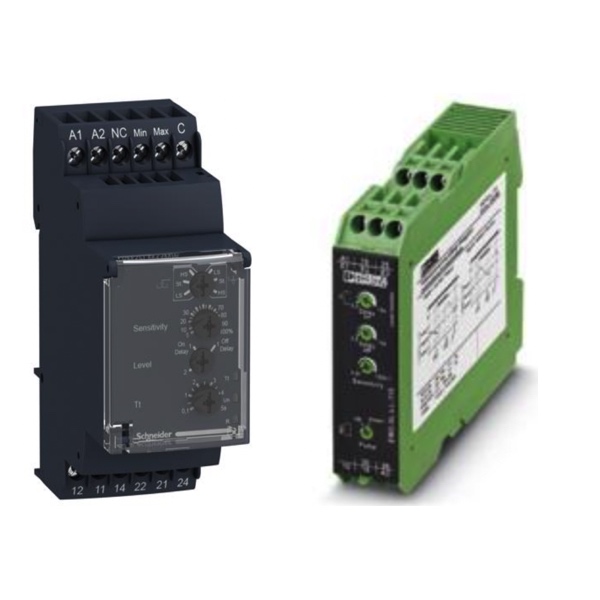Level Monitoring Relays

Level monitoring relays are used to monitor fill levels as well as mixing ratios. The relay monitors both a minimum and maximum value, allowing it to control pumps to protect against tank overflow and dry operation.
Schneider Electric Harmony Control Relays monitor and detect abnormal operating conditions concerning current, phase, voltage, frequency, liquid level, temperature, speed and pump control. This information allows users to initiate the necessary corrective actions before serious breakdowns occur. Settings can be configured digitally using the Zelio NFC App. Monitoring parameters can be set precisely to the desired value and time delay can be set to minutes, seconds or milliseconds. Harmony Control Relays are suitable for a wide range of applications including: packaging, lifts, textile, pumping, and water.
Phoenix Contact EMD Monitoring Relays are available for a wide range of monitoring tasks to keep them within limits or to avoid the consequences of errors. The operating states are indicated using colored LEDs. Errors that may occur can be sent to a control system via a floating contact or can shut down a part of the system. Some devices are equipped with startup and response delays in order to briefly tolerate measure values outside the set monitoring range.
Top 5 Things You Must Know About Relays
Voltage Matters
Most relays are identified using the voltage the coil is rated for. The contact side of the relay will be rated for an entirely different voltage. It is very common for the contact side of the relay to be rated up to 250V AC (or DC). It is also important to note that AC and DC coils are different, and are NOT interchangeable.
Know the difference between Normally Open (NO) and Normally Closed (NC)
Most relays have either a NO contact or a NC contact. It is most common to use the NO contact on a relay, however most circuits can function using one or the other depending on how it has been set up.
A Relay is Not a Contactor
Although relays and contactors function in much the same way, they are NOT the same. Contactors are generally used in scenarios where large amounts of voltage and current need to be switched, whereas relays don't typically switch more than 15 amps and 120V.
A Little Power Goes a Long Way
Relays switch higher voltage circuits with lower voltage control signals. This allows isolation of more sensitive control equipment from higher voltage circuits. Relays are a cheap and easy way to remotely turn and off these types of circuits.
Relays Can Be Used Both Ways
Although it is most common to see relays being used to switch higher voltage circuits, this is not the only way they can be used. Another use for relays is to monitor the “status” of certain devices, such as a motor. To do this, the relay would be wired so that the coil becomes energized when the motor is running. By doing this, a low voltage control signal is sent back to a PLC to signal that the motor is running.

